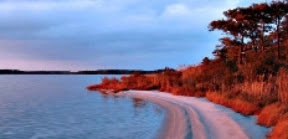Improving Maryland’s Coastal Bays
The United States Environmental Protection Agency has approved pollution limits set by Maryland to help improve water quality in the state’s coastal bays.
The limits approved by the EPA are contained in Total Maximum Daily Loads (TMDLs) for the nutrients nitrogen and phosphorus for the Maryland Coastal Bays.
 The Maryland Coastal Bays — Assawoman, Newport, Isle of Wight, Sinepuxent and Chincoteague Bays—lie between the barrier islands (Assateague Island and Ocean City) to the east and the mainland of Worcester County on the west. The Coastal Bays’ watersheds are connected to the Atlantic Ocean by inlets near Ocean City and near Chincoteague Island in Virginia. These shallow lagoons provide critical habitat for commercially important seafood and numerous wildlife species. Vacationers and tourists to the Ocean City and Assateague Island areas use the Coastal Bays for boating, water skiing, fishing and other recreational activities throughout the year.
The Maryland Coastal Bays — Assawoman, Newport, Isle of Wight, Sinepuxent and Chincoteague Bays—lie between the barrier islands (Assateague Island and Ocean City) to the east and the mainland of Worcester County on the west. The Coastal Bays’ watersheds are connected to the Atlantic Ocean by inlets near Ocean City and near Chincoteague Island in Virginia. These shallow lagoons provide critical habitat for commercially important seafood and numerous wildlife species. Vacationers and tourists to the Ocean City and Assateague Island areas use the Coastal Bays for boating, water skiing, fishing and other recreational activities throughout the year.
The Maryland Department of the Environment appreciates the support of Worcester County and our other partners in the Maryland Coastal Bays Program and the members of the Coastal Bays Implementation Committee,” said MDE Secretary Robert M. Summers. “Putting this blueprint into place to reduce pollution will continue to allow future generations of Marylanders to enjoy fishing, swimming and recreating in the waters of one of the State’s greatest natural treasures.”
Nutrients are, of course, essential for aquatic life. Over the past few decades, however, the Coastal Bays, like the Chesapeake Bay and many other water bodies, have received too much of a good thing. Excess nutrients cause eutrophication — a condition whereby too much algae grows in the water. The algae shade out submerged aquatic vegetation, killing off critically important habitat for crabs, oysters, and finfish. When the algae die off and decompose, they consume dissolved oxygen in the water that is needed by aquatic life to survive.
The nutrients in the Coastal Bays come from sources such as agricultural and urban stormwater runoff, septic systems, air deposition, shoreline erosion and wastewater treatment plants.
These TMDLs are blueprints for pollution reduction. The pollution limits are established using a state-of-the-art model and recent data to determine reductions needed to meet water quality standards. MDE scientists, working closely with scientists at the Virginia Institute for Marine Science, determined that it is necessary to reduce nutrients entering the bays by up to 35 percent in most areas. Some tributaries of the Isle of Wight Bay will need more reduction. The clean-up plan caps nutrients at their current amounts in Sinepuxent Bay to maintain that water body’s health.
The bays are primarily in Maryland, but they span three states. The TMDLs also assign Delaware and Virginia upstream aggregate allocations for nitrogen and phosphorus.
Worcester County, the Maryland Coastal Bays Program, the Maryland Department of Natural Resources, the town of Ocean City, EPA’s mid-Atlantic Region and MDE will work together to implement the pollution limits. Once this blueprint is implemented, water clarity and dissolved oxygen levels should improve. Submerged aquatic vegetation will flourish throughout the Coastal Bays, and aquatic life will thrive.
